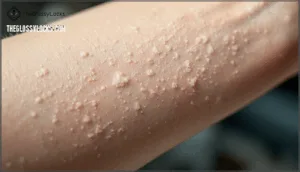This site is supported by our readers. We may earn a commission, at no cost to you, if you purchase through links.

Unlike dry skin, which lacks oil, dehydrated skin is thirsty for water, and it can happen to anyone, regardless of skin type. Your skin might produce plenty of sebum yet still feel uncomfortable and look dull.
The confusion between these two conditions leads many people down the wrong skincare path, using heavy moisturizers when they actually need hydration. Learning to spot the telltale signs means you’ll finally address what your skin truly needs.
Table Of Contents
- Key Takeaways
- What is Dehydrated Skin?
- How to Identify Dehydrated Skin
- Dehydrated Skin Vs. Dry Skin
- Common Triggers for Skin Dehydration
- Best Ways to Treat Dehydrated Skin
- Frequently Asked Questions (FAQs)
- How do I know if my skin is dehydrated?
- What does dehydrated skin mean?
- Is dehydration a symptom of dry skin?
- Can dehydrated skin lead to premature aging?
- How long does rehydrating skin typically take?
- Does drinking more water always fix dehydrated skin?
- Can you have dehydrated and dry skin together?
- Are there medical tests to confirm skin dehydration?
- Conclusion
Key Takeaways
- Dehydrated skin lacks water while dry skin lacks oil—this distinction matters because they require different treatments (humectants like hyaluronic acid for dehydration versus emollients and ceramides for dryness).
- You can identify dehydrated skin through visible signs like dullness, fine lines, and tight texture, plus the pinch test where skin that returns slowly after being pinched indicates water loss.
- Dehydration affects all skin types, including oily skin, which may overproduce sebum to compensate for water loss, leading to breakouts and congestion despite feeling greasy.
- Effective treatment combines hydration-focused products (layering humectants and occlusives), lifestyle adjustments (using humidifiers, drinking adequate water, avoiding harsh cleansers), and addressing internal factors like health conditions or medications that disrupt moisture retention.
What is Dehydrated Skin?
Dehydrated skin isn’t the same as dry skin, though they’re often confused. Understanding what causes dehydration and how it affects your skin—no matter your skin type—helps you choose the right treatment.
Let’s break down the basics so you know exactly what you’re dealing with.
Difference Between Dehydrated and Dry Skin
Though these two terms are often used interchangeably, dehydrated skin and dry skin aren’t the same thing—one lacks water, while the other lacks oil.
Dehydrated skin is a temporary condition affecting any skin type, while dry skin is a permanent skin type determined by genetics.
This difference between dry and dehydrated skin shapes your treatment approaches and product selection.
Causes of Skin Dehydration
Your skin loses water for several reasons. Environmental factors like UVB exposure and winter climate strip moisture from your skin’s surface, while harsh cleansers break down protective oils. Water intake matters too—when you don’t drink enough, your skin shows it.
Age-related decline in natural oils, indoor heating, and even certain medications contribute to water loss. These causes of dehydration can affect anyone, regardless of skin type.
Maintaining skin hydration is essential to prevent water evaporation.
How Dehydration Affects All Skin Types
Dehydration doesn’t discriminate—it shows up on oily, dry, and combination skin alike. Here’s how it affects different skin types:
- Oily skin overproduces sebum to compensate for water loss
- Dry skin becomes even tighter and flakier
- Combination skin shows uneven texture and increased oil in the T-zone
- Sensitive skin reacts with redness and irritation
- Acne-prone skin experiences more breakouts as pores become congested
Understanding your skin type helps you address dehydration effectively.
How to Identify Dehydrated Skin
Identifying dehydrated skin isn’t always obvious, especially since it can affect any skin type. Your skin often gives clear signals when it’s lacking water, from how it looks to how it feels throughout the day.
Let’s walk through the main ways you can recognize dehydration so you know exactly what to look for.
Visible Signs and Symptoms
Your skin gives clear signals when it’s running low on water. Skin dullness is one of the first giveaways—up to 90% of people with dehydration notice their complexion loses its natural glow. You might also spot fine lines, especially around your eyes and forehead, along with a rough, uneven skin texture that feels papery to the touch.
| What You’ll See | What You’ll Feel |
|---|---|
| Loss of radiance, flat tone | Tight, uncomfortable surface |
| Fine dehydration lines | Rough, bumpy patches |
| Dark circles, under-eye shadows | Increased sensitivity, mild itching |
Signs of dehydrated skin often include redness after cleansing, increased sensitivity to products, and more prominent dark circles. One indicator can be visible flakes of dead skin after applying makeup. These dehydrated skin symptoms can appear regardless of whether your skin is naturally oily or dry.
The Pinch Test for Dehydration
One quick skin check—often called the pinch test—can reveal whether your body is retaining enough water. Gently pinch a small section of skin on the back of your hand or forearm, keep for a few seconds, then release. If your skin snaps back quickly, you’re likely well-hydrated; if it returns slowly or stays tented, dehydration may be present.
- Test accuracy: While useful, the pinch test isn’t foolproof—age, genetics, and skin elasticity affect results, so combine it with other signs of dehydrated skin
- Technique variations: Try testing on your forearm, hand, or lower leg for a broader picture of hydration status across different body areas
- Interpreting results: Slow skin recoil suggests reduced turgor, a clinical marker of dehydration, but doesn’t distinguish dehydrated skin vs dry skin on its own
How Dehydrated Skin Feels
Your skin can actually tell you it’s thirsty—just through touch and sensation alone. Dehydrated skin often feels tight, especially after cleansing, and may become itchy or uncomfortable.
You’ll notice texture changes—rough patches or a lack of suppleness—and increased sensitivity to products you normally tolerate.
This discomfort intensity signals that your skin moisture levels have dropped, affecting overall skin hydration and triggering symptoms that differ from typical skin dryness.
Dehydrated Skin Vs. Dry Skin
People often confuse dehydrated skin with dry skin, but they’re not the same thing. One lacks water, the other lacks oil, and treating them requires different approaches.
Understanding the difference can help you choose the right products and get better results.
Key Characteristics of Dehydrated Skin
When your skin lacks water rather than oil, the result is a specific set of visual and textural changes. Dehydrated skin often presents with a dull complexion—up to 86% of affected individuals notice this lackluster appearance. Fine lines become more visible, and you’ll likely experience skin tightness, especially after cleansing, with over 70% reporting this sensation. Reduced hydration levels can drop by as much as 40% compared to normal skin, contributing to a loss of elasticity and a compromised ability to bounce back after the pinch test.
| Characteristic | What You’ll Notice | Clinical Findings |
|---|---|---|
| Appearance | Dull, lackluster complexion with visible fine lines | 86% report reduced radiance; 74% show microfolds |
| Texture | Tight, rough surface that feels uneven | 59% experience rough texture; 40% hydration decrease |
| Sensitivity | Increased reactivity, itching, or discomfort | 68% report itching; 60% feel persistent tightness |
| Elasticity | Skin doesn’t bounce back quickly when pinched | 85% show delayed retraction in turgor test |
| Tone | Patchy, uneven, or slightly gray appearance | 55% exhibit uneven tone; 62% show mild redness |
Identifying dehydrated skin helps you choose the right treatment approach, distinguishing it from dry skin, which lacks oil instead of water.
Key Characteristics of Dry Skin
Unlike dehydrated skin, dry skin is a skin type defined by lipid depletion—your body simply doesn’t produce enough natural oils. Around 29.4% of adults experience this condition, which increases considerably with age: up to 75% of people over 64 report moderate dry skin during winter. You’ll notice rough, flaky patches that feel tight and uncomfortable, with over 60% of affected individuals experiencing persistent itching.
| Characteristic | What You’ll Notice | Clinical Findings |
|---|---|---|
| Appearance | Visible flaking, scaly or ashy patches depending on skin tone | 29.4% adult prevalence; increases considerably with age |
| Texture | Rough, uneven surface with possible peeling | Over 60% report itching; surface cracks common |
| Barrier Function | Compromised protection, increased vulnerability to irritants | Ceramides depleted up to 30%; TEWL 2-3x higher |
| Common Comorbidities | Higher risk of eczema, psoriasis, dermatitis | 4.0x odds ratio for atopic eczema; 2.96x for exsiccation eczema |
| Environmental Impact | Symptoms worsen in low humidity, cold weather | 60% report winter symptoms; hot water worsens condition |
Treating dry skin requires moisturizers rich in emollients and ceramides to restore barrier function and lock in hydration, addressing the underlying lipid deficiency rather than just water loss.
Why Distinguishing Them Matters
Treating them the same way is like watering a plant with cracked soil versus one that needs fertilizer—both look wilted, but only the right fix will work. Identifying dehydrated skin versus dry skin guarantees you’re targeting the root problem, not just masking symptoms. Using the wrong treatment can worsen irritation, waste money on ineffective products, and delay the long-term health your skin actually needs.
Treating dehydrated versus dry skin wrong is like watering cracked soil instead of adding fertilizer—only the right fix works
| Factor | Dehydrated Skin | Dry Skin |
|---|---|---|
| Treatment Focus | Hydration (water-binding ingredients) | Moisturization (oil-replenishing formulas) |
| Product Selection | Hyaluronic acid, glycerin, aloe vera | Ceramides, fatty acids, emollients |
| Wrong Approach Risk | Heavy oils may clog without fixing water loss | Humectants alone won’t restore lipid barrier |
| Treatment Effectiveness | Targeted solutions restore plumpness quickly | Long-term health requires consistent barrier repair |
| Prevention Strategy | Drink water, avoid harsh cleansers, use humidifier | Limit hot showers, apply rich creams, protect from cold |
Common Triggers for Skin Dehydration
Understanding what triggers skin dehydration can help you prevent it before it starts. The culprits range from everyday habits you mightn’t think twice about to health conditions that affect your body’s water balance.
Let’s look at what’s actually draining moisture from your skin.
Environmental and Lifestyle Factors
Climate effects and seasonal changes can strip moisture from your skin faster than you realize. Cold, dry air drops humidity below 30%, weakening your barrier and boosting water loss.
UV exposure degrades protection, while air pollution triggers inflammation that dehydrates skin.
Lifestyle factors matter too—smoking reduces moisture, and outdoor physical activity increases sunburn risk. These environmental factors and lifestyle choices directly impact your skin’s ability to stay hydrated.
Skincare Habits That Worsen Dehydration
Even well-intentioned skincare routines can backfire if you’re using harsh products or overwashing your face. Over-exfoliation strips your barrier, hot showers pull moisture out, and harsh cleansers disrupt your skin’s pH balance.
Common habits that cause dehydrated skin include:
- Skipping moisturizer after cleansing
- Ignoring SPF during sun exposure
- Using alcohol-based toners that dry you out
An inconsistent routine won’t give your skin the steady support it needs to stay hydrated.
Internal Causes and Health Conditions
Your skin doesn’t dry out in isolation—what’s happening inside your body matters just as much as what you’re putting on it. Underlying illnesses like systemic diseases and hormonal conditions can trigger dehydration symptoms beyond your skin.
Medication effects, poor diet, and insufficient fluid intake also disrupt hydration levels. Hormonal imbalances during menopause or thyroid issues affect moisture retention.
Addressing these underlying health conditions through lifestyle changes and proper hydration benefits your skin from within.
Best Ways to Treat Dehydrated Skin
Treating dehydrated skin requires a targeted approach that tackles water loss while strengthening your skin’s protective barrier. You’ll need the right combination of hydrating products, beneficial ingredients, and daily habits to restore moisture balance.
Let’s explore the most effective strategies to bring your skin back to health.
Hydration-Focused Skincare Routine
A good skincare routine for dehydrated skin doesn’t need to be complicated, but it does need to focus on getting water back into your skin and keeping it there. Hydration layering works best when you start with lightweight humectants and build up to heavier moisturizers that seal everything in.
Here’s what routine consistency looks like:
- Cleanse gently — Use a hydrating, non-foaming cleanser that won’t strip your skin
- Apply a hydrating serum — Look for humectant-rich formulas while your skin is still slightly damp
- Moisturize immediately — Lock in hydration with a cream containing emollients and ceramides
- Use overnight masks — These provide deep, sustained hydration while you sleep
Product Ingredients to Look For
When you’re shopping for dehydrated skin, ingredient labels matter. The key is combining humectants that pull water in with lipids that keep it locked down. Hyaluronic acid holds up to 1,000 times its weight in water, while glycerin boosts hydration by 33%. Ceramides rebuild your skin’s barrier, and niacinamide improves water retention while calming redness.
| Ingredient Type | What It Does | Top Examples |
|---|---|---|
| Humectants | Draw water into skin layers | Hyaluronic acid, glycerin, panthenol |
| Lipid barriers | Seal moisture and prevent water loss | Ceramides, cholesterol, squalane |
| NMF components | Mimic skin’s natural moisturizing factors | Urea, amino acids, sodium PCA |
| Soothing agents | Calm irritation and support hydration | Centella asiatica, aloe vera, beta-glucans |
Emerging ingredients like polyglutamic acid and topical exosomes are showing promise in 2025 research. Look for emollient moisturizers that combine multiple hydrating elements—not just one superstar ingredient.
At-Home Remedies and Tools (e.g., Humidifiers)
Beyond ingredients and products, simple home strategies can reshape how your skin holds onto water. A humidifier adds moisture back into dry indoor air, especially during winter months. Lukewarm showers protect your barrier better than hot water, and drinking six to eight glasses daily aids oral hydration from within.
Gentle cleansers won’t strip essential oils, while hydrating foods like cucumbers and watermelon boost water levels naturally.
When to Seek Professional Advice
If home care hasn’t brought relief within two to three weeks, or if you’re dealing with persistent itching, peeling, or signs of infection, it’s time to consult a dermatologist.
Persistent symptoms or treatment resistance may signal underlying conditions that need individualized guidance. A dermatologist or aesthetician can assess your skin health, rule out other skin conditions, and recommend targeted skin treatment for lasting results.
Frequently Asked Questions (FAQs)
How do I know if my skin is dehydrated?
Your skin tells you it’s dehydrated through specific symptoms you can check yourself. The skin pinch test reveals how quickly your skin bounces back, while post-cleanse tightness and fine line visibility indicate low hydration levels.
Dullness and overall skin appearance also signal dehydration that needs treatment.
What does dehydrated skin mean?
Dehydrated skin occurs when your epidermal hydration levels drop, meaning your skin lacks water rather than oil.
Transepidermal water loss can increase up to 30 times when your skin barrier is compromised, disrupting cellular water balance and dermal water content throughout all skin types.
Is dehydration a symptom of dry skin?
No, dehydration isn’t a symptom of dry skin—they’re separate conditions. Dry skin lacks oil, while dehydrated skin lacks water. However, symptom overlap creates misconceptions since both show flaking and tightness.
Combined care addressing your skin barrier helps treat dehydrated skin and dry skin effectively.
Can dehydrated skin lead to premature aging?
Like a plant wilting without water, your skin cells struggle without hydration. Yes, dehydrated skin accelerates premature aging signs through collagen breakdown and elastin damage.
Water loss triggers wrinkle formation, slows cellular turnover, and depletes antioxidants. You’ll notice skin elasticity loss faster.
Treating dehydrated skin promptly protects against early skin aging.
How long does rehydrating skin typically take?
Rehydration timeline varies, but you’ll usually notice improvement within a few days of consistent skin hydration methods and lifestyle changes for skin health.
Treating dehydrated skin effectively depends on factors affecting product efficacy and your body’s response, so set realistic expectations—full recovery may take two to four weeks.
Does drinking more water always fix dehydrated skin?
Not always. Water intake aids internal hydration, but dehydrated skin often stems from a compromised skin barrier that can’t retain moisture.
Treating dehydrated skin requires both drinking water and using topical products with humectants and occlusives.
Lifestyle factors like harsh cleansers or low humidity also cause dehydration, requiring more than just increased water consumption.
Can you have dehydrated and dry skin together?
Yes, you can have both conditions at once. Dry skin lacks oil production, while dehydrated skin needs water.
Combined skin conditions require layering products—humectants for internal hydration and emollients for barrier repair.
Treating dehydrated skin alongside symptoms of dry skin means addressing causes of dehydrated skin through dual-action treatment.
Are there medical tests to confirm skin dehydration?
Your dermatologist can measure TEWL (transepidermal water loss), which shows how much moisture evaporates from your skin’s surface, or use corneometry analysis to assess skin hydration levels and confirm clinical dehydration signs beyond home tests.
Conclusion
An ounce of prevention is worth a pound of cure—and that applies to your skin barrier as much as anything else. Now that you know how to tell if skin is dehydrated, you can stop second-guessing your complexion and start addressing what’s really going on.
Whether it’s adjusting your water intake, swapping harsh cleansers, or layering in humectants, small changes add up quickly. Your skin won’t fix itself overnight, but with consistent hydration, you’ll notice a real difference within days.









